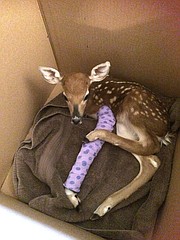Don't become a 'fawn napper'
Every year, fawns are reported by the caring public as being orphaned or abandoned.
Sometimes it is a case of death of the doe, leaving the fawn obviously orphaned. Sometimes it is a case of an injured fawn, causing the doe to abandon her baby. But, unfortunately, it is often a case of not being orphaned at all, but rather the mother just being out of sight, said Dory McIsaac of Mystic Farm Wildlife Rescue in Sagle.
“Nothing pleases my heart more than knowing a fawn is back with its mom,” McIsaac said. “Each season Mystic Farm receives phone calls regarding ‘abandoned’ fawns. Our pat response — if no blatant death of a doe is observed — is to please put the fawn back where you found it.”
They advise callers that it doesn’t matter if they touched it — and if it makes them feel better, rub some grass on it, put the fawn down and leave the area.
“I can almost guarantee that if you go back and check in 24 hours, the fawn will be gone,” McIsaac said. “Nearly every situation ends with the ‘fawn napper’ calling Mystic Farm back the next day to let us know the mama came back to get the fawn. That is truly the desired happy ending of wildlife rehabilitation.”
If you come across a lone fawn, do not touch. Keep a distance and call Mystic Farm Wildlife Rescue or an Idaho Department of Fish and Game officer. An assessment of the situation will be made and proper measures taken if warranted. In the event the fawn truly is orphaned and is deemed a viable candidate for rehabilitation, Mystic Farm Wildlife Rescue is available. By providing shelter, food and medical care, trained Mystic Farm staff can help orphaned and/or injured wildlife until they can be “soft released” back into their natural habitat.
Some facts to know:
- Mother deer will leave their fawn for hours while they go off to feed nearby. The mother does this so predators will not see a vulnerable fawn when they see her. She can be gone many hours, leaving the camouflaged and scent free fawn motionless, avoiding detection by predators.
- Is it injured? If a fawn is seen lying upright, eyes wide open, but flattened to the ground, do not touch it. This is a fawn’s camouflage position to blend in with its surroundings. When the fawn is picked up, it will allow its body to become limp and dangle in your hands. The legs are not broken. Put the baby down, walk away and leave the area.
- If a fawn is obviously ill or injured — lying on its side, kicking and crying, bleeding, etc. — gently pick it up and place in a safe, quiet place. A light cloth placed over the eyes will often calm it. Keep the fawn away from pets and other human activity. Touch, odors, and the sound of the human voice will only add to the stress of the situation and may cause additional harm. Keep the fawn free from cold drafts or keep it cool if the weather is warm. Please do not feed the fawn. Call Mystic Farm immediately.
- The fawn is on the road. Mystic Farm receives many calls regarding fawns in the middle of the road. Why are they there? Because the mom is nearby. If the fawn is in danger of being hit by cars, gently pick it up and place it about 20 feet off the side of the road and leave the area.
- Is it too late to return to the mother if the fawn has been handled by humans? Will she then reject it? No. That is an “old wives tale.” The mother doesn’t care — she just wants her baby back. She is around human scent all the time. Her maternal instinct is much stronger than her ability to rationalize human scent on her baby.
- What happens to the fawn if a rescue is warranted? After arrival at Mystic Farm, the fawn is evaluated and checked for any injuries, dehydration, etc. Wounds are treated either on the premises or through the services of local veterinarians. The fawn is put on an appropriate diet and feeding schedule. Once the fawns gain strength and can nurse from a bottle on their own, the “blind feeding method” is utilized using “hands off” bottle racks. Human contact is kept to a minimum. The fawns are kept in an isolated area — free from predators and forming their own little “herd.” They are free to browse and live in a large, safe, enclosure. Over the course of the season, the fawns are slowly introduced back into the wild.
Information: Mystic Farm Wildlife Rescue Inc., (208) 241-7081



